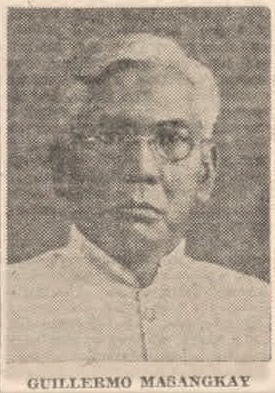Guillermo Masangkay (1867-1963) "ALAKDAN"
Alakdan
In 1935, a group of Manila newspapers undertook a project to find out who was still alive among the original founders and members of the Katipunan Methodically, the said veterans, "Sons of the People" were searched in Manila and the suburbs. Through meticulous research and inquiry, no more than thirty were successfully identified and located. One of those approached to give his opinion to the initiative was none other than Guillermo Masangkay, one of the early members of the Katipunan
Guillermo Masangkay found it hard to accept that only 25 of the original founders of Katipunan surfaced. He promptly voiced his disbelief, stating, "It can't be possible that there are 25 original founders of Katipunan who are still alive today as as published in certain section of the Manila press. There are hundreds of the original thousands are living in obscurity who tore up their cedulas in Kangkong where the first cry of rebellion was made. and they are not heard from because as true Katipuneros they not prone to talking about their past glorious I repeat, there are hundreds of them still living around San Juan del Monte, Mandaluyong, and Manila.
Guillermo Masangkay was born on June 25, 1867, in Tondo, Manila, to Domingo Masangkay and Victoria Rafael. He served as a trusted confidante and advisor to the Supremo, and actively participated in numerous significant historical events of the Katipunan. Following the passing of the Supremo, the conclusion of the revolution, and the onset of the American colonial era, Masangkay maintained a strong bond with the relatives and friends of the Supremo. He took it upon himself to ensure that the memory of the Supremo was upheld with great reverence.--His nom de guerre was "Alakdan."
The Boni Monument
It was Guillermo Masangkay who initiated an effort to construct a monument in honor of the Supremo. This endeavor garnered the support of the then Speaker of the House, Sergio Osmeña Sr. and Secretary of Interior Teodoro Kalaw. Remarkably, as early as 1916, Masangkay approached Osmena with the concept, urging for allocation of funds for the Bonifacio monument. Osmeña swiftly embraced the idea and advised Masangkay to also confer with the then Secretary Kalaw, who promptly granted approval.
Kalaw proceeded to conduct a comprehensive assessment of the proposal and prepared the requisite documentation in collaboration with the legislature Subsequently, the project was presented to the legislature, where Osmeña ensured its passage. Thus, on February 23, 1918, the bill to establish a Bonifacio Monument, backed by initial funding of 25,000 pesos, as sanctioned by the Secretary of Interior, was successfully enacted into law. Yet the 25,000 peso funds was deemed insufficient that including some public donation it reached 42.000 pesos. The project was mothballed for almost a decade.
On September 30, 1929, a contest was announced to design a monument in honor of the great plebeian. The first prize was bestowed upon Guillermo Tolentino, while Juan Nakpil secured the second position. The panel of judges included Andres Luna de San Pedro, Tomas Mapua, and Vicente Francisco. Nonetheless, progress on the project seemed to stall, and despite the announcement of winners, little headway was made. It was at this juncture, a decade following the project's inception, that then Senate President Manuel L. Quezon intervened to augment the available funds.
On November 30, 1929, which marked Bonifacio Day, the Senate granted approval for a bill allocating an additional 97,000 pesos towards the construction of the Bonifacio monument. Consequently, the overall funds allocated for the monument reached approximately 130,000 pesos. It was on this very same day, November 30, 1929, that Mrs. Aurora Quezon, the wife of then Senate President Manuel Quezon, laid the symbolic cornerstone for the monument in Caloocan.
A controversy arose during the planning stages for the inauguration of the monument in September 1933. The omission of Sergio Osmeña as one of the guest speakers sparked vehement protest from Guillermo Masangkay. It was only when he threatened to resign from the committee that Osmeña's name was added to the list of speakers.
In his address during the inauguration of the National Monument for Andres Bonifacio, November 30 1933, Osmeña commended Guillermo Masangkay for his pivotal role in realizing the monument for the Supremo, stating: "In all of these popular manifestations as well as in the construction of the monument which has now been unveiled, public recognition should be made of the important role which had been played by the modest worker, the faithful follower of Bonifacio, Mr. Guillermo Masangkay " .
Leaders of Integrity
In 1935, when questioned about his stance on the Commonwealth's proposal to provide pensions to the Katipuneros, Masangkay responded that he would decline the pension offered by the government. He, along with certain former Katipuneros, proclaimed that it was already enough that they fulfilled their duty to the people. He expressed, "All I desire is for us to have a government characterized by honesty and tranquility, led by leaders of integrity."
Masangkay passed away in 1963. It can be said that his life after the revolution was primarily dedicated to preserving the memory of Andres Bonifacio's cause. He similarly remained vigilant against those who sought to denigrate the Supremo. Their actions and words were often met with his resolute opposition.
He lived up to his nom de guerre , Alakdan (Scorpion)

.png)


Comments
Post a Comment